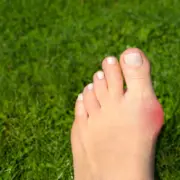Bunion? Hammer toe? Ingrown toenail? What’s causing my foot pain?
Does foot pain dominate your day-to-day life? Whether you’re on your feet all day at work, put in a lot of miles on hard surfaces, or are feeling the consequences of unforgiving shoe styles, you don’t have to live with foot pain! Bunions, hammer toe, and ingrown toenails are three common causes of foot pain that can be addressed, often with non-surgical solutions. Learn more about causes, prevention and treatment options for all three.
Bunions
What causes bunions?
A bunion is a bony bump that develops slowly at the base of your big toe due to inward pressure on your toe joint, or arthritis. Bunions are very common – especially among women. In fact, almost one fourth of adults (age 18-65) have bunions. That number goes up to more than one third if you’re over 65.
Pressure pushes the top of your big toe toward your other toes, which in turn pushes the base of your toe outward, eventually causing a bump. Over time this bump – and the pain that comes with it – tend to get more extreme.
How are bunions treated?
Typically, your orthopedic specialist will recommend non-surgical options first. These include adding padding or inserts to your shoes to reduce the pressure and changing the types of shoes that you wear to an option that doesn’t put pressure on your toes. Other non-surgical options include taking an anti-inflammatory medication.
When surgery is needed: When your bunion pain is too great to walk or wear shoes and other treatments are not helping enough, your doctor may recommend bunion surgery. Surgical methods may vary depending on your bunion, but generally serve to realign the joint and bring the big toe back to its intended position. Surgery is typically done on an outpatient basis.
Hammer toe
While bunions involve the big toe or baby toe (called a bunionette), hammer toe impacts any of the middle three toes. As the name implies, the toe takes the shape of a hammer as it bends at the middle joint. Poor fitting shoes, paired with other factors, are often the culprit in hammer toe cases too. Pressure forces the toe into a bent position and over time the muscles cannot straighten.
What’s the best treatment for hammer toe?
It’s important to seek diagnosis and treatment of a hammer toe, because they are more easily corrected when not severe. When left untreated, they are more likely to become rigid and require surgery. Treatment again starts with wearing shoes that better fit your forefoot. Avoiding narrow shoes, and especially high heels with narrow toe boxes is especially important.
There’s also physical therapy for your toes! This includes stretches and even exercises that strengthen your toes to allow them to return to their intended resting position. You can practice picking things (like a marble) up off the floor or use your toes to scrunch a cloth or towel. There are also a variety of pads and cushions that might help relieve your symptoms too.
If exercise and shoe changes do not help, surgery can be performed to straighten the joint. This is also an outpatient procedure with a fairly short recovery.
Ingrown toenail
Ingrown toenails – a condition where skin grows over the side of the nail or the nail begins to grow into the skin – often cause swelling and pain. It’s most commonly seen on the big toe. You can prevent ingrown toenails or at least minimize their likelihood by being careful not to cut your nails too short and avoiding rounding their shape at the corners. Trauma, or shoes that are too short or too tight can also contribute to ingrown toenails.
Ingrown toenail treatment
Because they are painful, people typically want to treat them quickly. This is also a good idea to avoid infection and the need for further treatment. You can soak your foot in warm water to ease the pain but be sure the foot is clean and dry at other times. Again (surprise!) wear comfortable shoes, or even sandals. If you can (gently) separate the toenail from the skin, you can use a bit of cotton swap or dental floss to create some separation while it heals. Make sure you change this wrapping out daily and keep it clean to avoid infection.
If you have considerable swelling, pain or puss, an infection is likely, and you should see a doctor. They can either partially or fully remove the nail and prescribe antibiotics if necessary.
Whether one of these three foot conditions matches up with your symptoms or not, taking great care of your feet should always be a priority. If you have chronic foot pain that’s impacting your ability to work, walk or exercise, it may be time to see a podiatric specialist. Schedule a time to come see us (in roomy comfortable shoes, of course)!
Dr. Fred Hainge is one of CCOE’s board-certified podiatric surgeons specializing in foot and ankle conditions.







